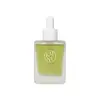What's inside
What's inside
 Key Ingredients
Key Ingredients

 Benefits
Benefits

 Concerns
Concerns

No concerns
 Ingredients Side-by-side
Ingredients Side-by-side

Water
Skin ConditioningDipropylene Glycol
HumectantDiglycerin
HumectantAdansonia Digitata Fruit Extract
EmollientNiacinamide
Smoothing1,2-Hexanediol
Skin ConditioningPolyglycerin-3
HumectantButylene Glycol
HumectantBetaine
HumectantGluconolactone
Skin ConditioningXanthan Gum
EmulsifyingSodium Citrate
BufferingGellan Gum
Calcium Chloride
AstringentPrunus Mume Fruit Extract
HumectantCarica Papaya Fruit Extract
Skin ConditioningMalus Domestica Fruit Extract
AntioxidantVitis Vinifera Fruit Extract
Skin ConditioningAdenosine
Skin ConditioningDipotassium Glycyrrhizate
HumectantMelia Azadirachta Leaf Extract
Skin ConditioningMaltodextrin
AbsorbentMelia Azadirachta Flower Extract
Skin ConditioningLecithin
EmollientBiosaccharide Gum-1
HumectantTremella Fuciformis Sporocarp Extract
AntioxidantSodium Hyaluronate
HumectantTocopherol
AntioxidantSuccinic Acid
BufferingEthylhexylglycerin
Skin ConditioningDisodium EDTA
Water, Dipropylene Glycol, Diglycerin, Adansonia Digitata Fruit Extract, Niacinamide, 1,2-Hexanediol, Polyglycerin-3, Butylene Glycol, Betaine, Gluconolactone, Xanthan Gum, Sodium Citrate, Gellan Gum, Calcium Chloride, Prunus Mume Fruit Extract, Carica Papaya Fruit Extract, Malus Domestica Fruit Extract, Vitis Vinifera Fruit Extract, Adenosine, Dipotassium Glycyrrhizate, Melia Azadirachta Leaf Extract, Maltodextrin, Melia Azadirachta Flower Extract, Lecithin, Biosaccharide Gum-1, Tremella Fuciformis Sporocarp Extract, Sodium Hyaluronate, Tocopherol, Succinic Acid, Ethylhexylglycerin, Disodium EDTA
Water
Skin ConditioningLactic Acid
BufferingDipropylene Glycol
HumectantGlycerin
HumectantButylene Glycol
HumectantMethylpropanediol
SolventSodium Hydroxide
Buffering1,2-Hexanediol
Skin ConditioningRosmarinus Officinalis Leaf Extract
AntimicrobialHydroxyethylcellulose
Emulsion StabilisingSuccinic Acid
BufferingPropanediol
SolventEthylhexylglycerin
Skin ConditioningMelia Azadirachta Leaf Extract
Skin ConditioningHydrolyzed Gardenia Florida Extract
AntioxidantHydrolyzed Malt Extract
Skin ConditioningHydrolyzed Viola Tricolor Extract
Skin ProtectingGlyceryl Acrylate/Acrylic Acid Copolymer
HumectantMelia Azadirachta Flower Extract
Skin ConditioningAllantoin
Skin ConditioningBetaine
HumectantPanthenol
Skin ConditioningHyaluronic Acid
HumectantHydrolyzed Hyaluronic Acid
HumectantSodium Hyaluronate
HumectantWater, Lactic Acid, Dipropylene Glycol, Glycerin, Butylene Glycol, Methylpropanediol, Sodium Hydroxide, 1,2-Hexanediol, Rosmarinus Officinalis Leaf Extract, Hydroxyethylcellulose, Succinic Acid, Propanediol, Ethylhexylglycerin, Melia Azadirachta Leaf Extract, Hydrolyzed Gardenia Florida Extract, Hydrolyzed Malt Extract, Hydrolyzed Viola Tricolor Extract, Glyceryl Acrylate/Acrylic Acid Copolymer, Melia Azadirachta Flower Extract, Allantoin, Betaine, Panthenol, Hyaluronic Acid, Hydrolyzed Hyaluronic Acid, Sodium Hyaluronate
 Reviews
Reviews

Ingredients Explained
These ingredients are found in both products.
Ingredients higher up in an ingredient list are typically present in a larger amount.
1,2-Hexanediol is a synthetic liquid and another multi-functional powerhouse.
It is a:
- Humectant, drawing moisture into the skin
- Emollient, helping to soften skin
- Solvent, dispersing and stabilizing formulas
- Preservative booster, enhancing the antimicrobial activity of other preservatives
Betaine is a common humectant (a substance that promotes retention of moisture). It's known to be gentle on the skin and can help balance hydration.
This ingredient is best for improving hydration and soothing irritated skin. Studies also show it helps even out skin tone.
Fun fact: Betaine is naturally created in the skin and body. The kind found within cosmetic products can be either plant-derived or synthetic.
Another name for betaine is trimethylglycine.
Learn more about BetaineButylene Glycol (or BG) is used within cosmetic products for a few different reasons:
Overall, Butylene Glycol is a safe and well-rounded ingredient that works well with other ingredients.
Though this ingredient works well with most skin types, some people with sensitive skin may experience a reaction such as allergic rashes, closed comedones, or itchiness.
Learn more about Butylene GlycolDipropylene Glycol is a synthetically created humectant, stabilizer, and solvent.
This ingredient helps:
Dipropylene glycol is technically an alcohol, but it belongs to the glycol family (often considered part of the ‘good’ alcohols). This means it is hydrating and gentle on skin unlike drying solvent alcohols like denatured alcohol.
As a masking agent, Dipropylene Glycol can be used to cover the smell of other ingredients. However, it does not have a scent.
Studies show Dipropylene Glycol is considered safe to use in skincare.
Learn more about Dipropylene GlycolEthylhexylglycerin (we can't pronounce this either) is commonly used as a preservative and skin softener. It is derived from glyceryl.
You might see Ethylhexylglycerin often paired with other preservatives such as phenoxyethanol. Ethylhexylglycerin has been found to increase the effectiveness of these other preservatives.
Melia Azadirachta Flower Extract is from the Neem tree. Neem trees originate from India.
Melia Azadirachta Flower Extract contains antioxidants. Antioxidants help fight free-radicals. Free-radicals are molecules that may damage your skin cells, such as pollution.
The flowers of this tree are lilac colored.
Learn more about Melia Azadirachta Flower ExtractMelia Azadirachta Leaf Extract is extract from the neem plant.
The leaves of this tree contain flavonoids and polyphenols. These two compounds are antioxidants, anti-inflammatory, and antibacterial. Further research is needed as to their effects when applied on skin.
Sodium Hyaluronate is hyaluronic acid's salt form. It is commonly derived from the sodium salt of hyaluronic acid.
Like hyaluronic acid, it is great at holding water and acts as a humectant. This makes it a great skin hydrating ingredient.
Sodium Hyaluronate is naturally occurring in our bodies and is mostly found in eye fluid and joints.
These are some other common types of Hyaluronic Acid:
Learn more about Sodium HyaluronateSuccinic acid is an odorless white powder. It is naturally found in our bodies but can also be derived from living organisms.
Succinic acid is water-soluble. The pH level of this ingredient is between 4.2 and 5.6.
While succinic acid posesses antimicrobial, antioxidant, and anti-inflammatory properties, these properties have not been studied in skincare products.
Fun fact: Succinic acid was known as the 'spirit of amber' in the past. This is because it used to be derived from distilling amber.
Learn more about Succinic AcidWater. It's the most common cosmetic ingredient of all. You'll usually see it at the top of ingredient lists, meaning that it makes up the largest part of the product.
So why is it so popular? Water most often acts as a solvent - this means that it helps dissolve other ingredients into the formulation.
You'll also recognize water as that liquid we all need to stay alive. If you see this, drink a glass of water. Stay hydrated!
Learn more about Water